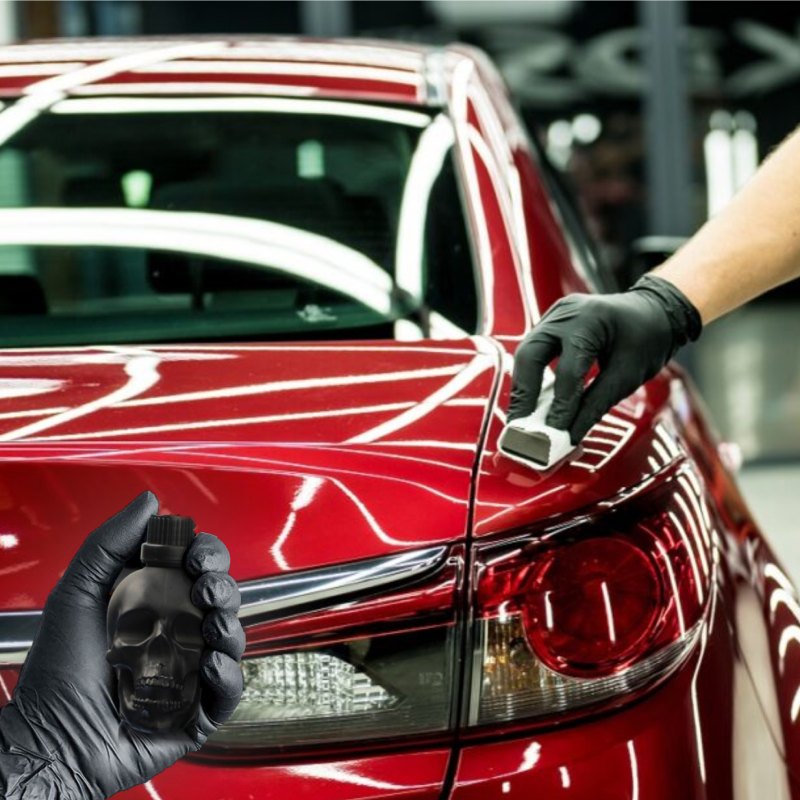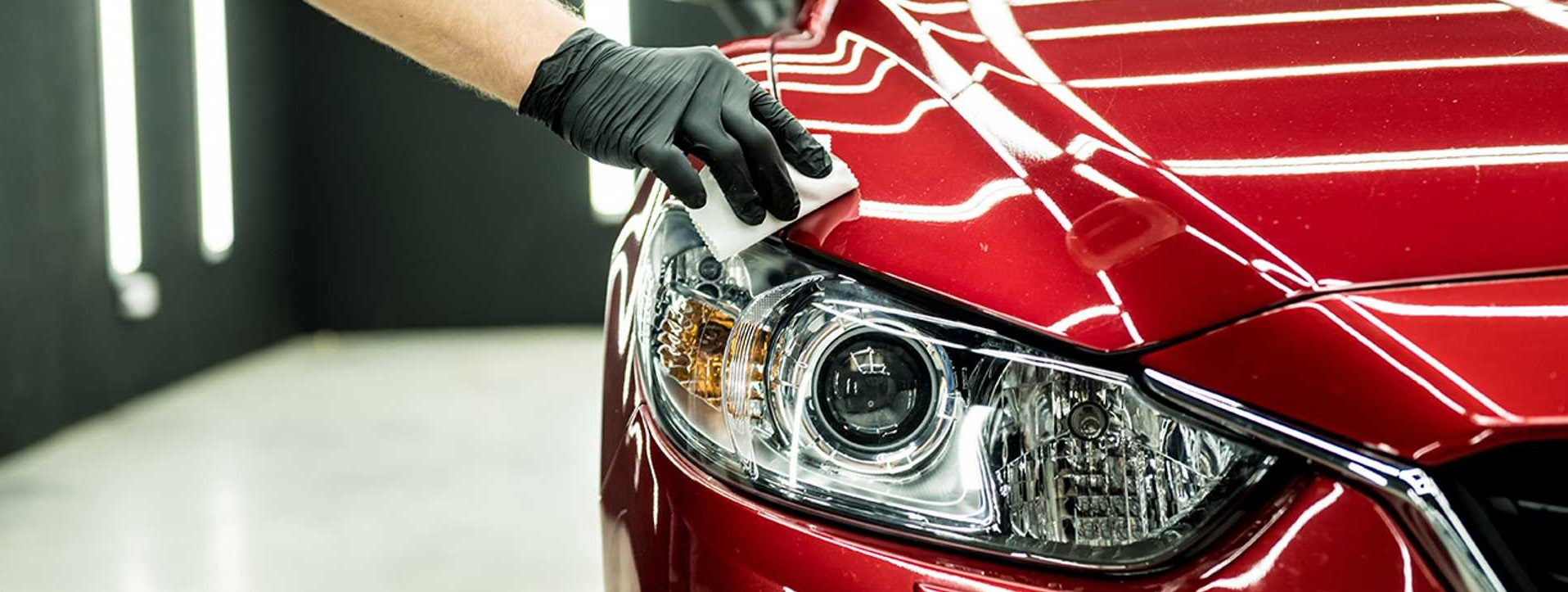Ceramic Coating Newark: Before and after you need to see
Wiki Article
Checking out the Scientific Research Behind Car Ceramic Coating and Its Protective Qualities
The scientific research of car ceramic coating provides a remarkable research study in innovative vehicle protection. Composed mainly of silicon dioxide and polymers, these layers create a robust bond with automobile paint. This interaction improves resilience against ecological hazards while supplying hydrophobic advantages. However, the intricacies of just how these coverings job and their lasting advantages continue to be much less understood. Unboxing these details reveals why ceramic finishes are coming to be a favored selection for car treatmentWhat Is Ceramic Coating?
Ceramic coating is a fluid polymer that chemically bonds to the surface of a car's paint. This advanced safety layer boosts durability and uses premium resistance to environmental elements. Unlike traditional wax or sealants, which supply temporary defense, ceramic finishings create a lasting shield that can stand up to severe problems such as UV rays, acidic impurities, and extreme weather. When used properly, the coating forms a hydrophobic surface area, creating water to bead and slide off, which helps in keeping the vehicle's cleanliness. Additionally, it supplies enhanced gloss and depth to the paint, making the vehicle show up even more refined and dynamic. The application procedure generally involves extensive surface area preparation, consisting of cleaning and sprucing up, to assure peak bonding. Consequently, ceramic finishings are coming to be progressively preferred amongst car enthusiasts and those looking for to safeguard their financial investments, assuring to maintain the automobile's visual charm while minimizing the regularity of upkeep.The Make-up of Ceramic Coatings
The intricate solution of ceramic finishings mainly consists of silicon dioxide (SiO2), which is obtained from natural resources like quartz and sand. This essential element gives the structure for the coating's sturdiness and safety top qualities. Along with SiO2, ceramic coverings typically consist of numerous polymers and ingredients that enhance adhesion, adaptability, and resistance to ecological variables. These substances function synergistically to create a durable obstacle versus impurities such as dirt, chemicals, and UV rays.Furthermore, some formulas incorporate titanium dioxide (TiO2) or other nanomaterials, which can increase the coating's hydrophobic properties, resulting in better water repellency. The precise composition can differ significantly among manufacturers, influencing performance and long life. Ultimately, the mix of these components finishes in a safety layer that not only boosts the aesthetic allure of lorries yet also serves to extend their life expectancy by shielding the surface area from potential damages.Just How Ceramic Coatings Job
Recognizing exactly how ceramic layers function involves exploring their chemical composition, which adds to their safety high qualities. The application process is important for achieving ideal results, while long life and longevity variables establish the coating's performance in time. With each other, these aspects highlight the benefits and performance of ceramic layers for lorry defense.Chemical Make-up Explained
While many car proprietors look for lasting protection for their automobiles, the chemical composition of ceramic finishes plays an essential function in their performance. These coatings primarily include silicon dioxide (SiO2), which is obtained from natural minerals. This compound develops a solid bond with the automobile's paint, developing a durable, protective layer. Furthermore, several ceramic finishings consist of titanium dioxide (TiO2), enhancing their hydrophobic buildings and resistance to UV rays. The existence of polysiloxanes can better boost versatility and durability. With each other, these elements add to the coating's ability to ward off water, dust, and impurities, while additionally giving a high-gloss finish. Recognizing this chemical foundation aids car owners value the robust protection provided by ceramic finishes.Application Process Summary
Applying ceramic finishes includes a precise process that assures optimal bonding and defense for the automobile's surface. Comprehensive cleaning and purification of the car's exterior are executed to get rid of dirt, crud, and previous waxes. This action verifies that the surface area is devoid of impurities that can hinder attachment. Following this, the paint is often polished to boost clarity and eliminate any flaws. When prepared, the ceramic coating is applied in tiny areas making use of an applicator pad, permitting consistent insurance coverage. The coating is then delegated heal, creating a strong chemical bond with the surface. Appropriate curing times and problems are essential, as they confirm the coating accomplishes its optimum performance and protective high qualities.Durability and Durability Factors
Ceramic coatings are developed to provide lasting defense via their sophisticated chemical composition, which produces a durable obstacle against ecological contaminants. The toughness of these layers is affected by variables such as the thickness of the application, the top quality of the product, and the problems under which the car is revealed. Top notch ceramic finishes can last several years, withstanding scratches, UV rays, and chemical discolorations. Proper upkeep, consisting of regular washing and routine reapplication, can additionally boost durability. Furthermore, ecological elements like environment and exposure to contaminants can impact the lifespan of the coating. Overall, when applied and preserved correctly, ceramic finishes offer phenomenal toughness, making them a preferred option for car enthusiasts looking for to protect their car's look.Hydrophobic Qualities and Water Repellency
Hydrophobic residential or commercial properties are a trademark of high quality car ceramic layers, significantly enhancing the automobile's surface performance. These finishings create a molecular bond with the car's paint, causing a surface that repels water efficiently. When water enters into call with a ceramic-coated surface area, it beads up and rolls off, decreasing the quantity of fluid that remains on the paint. This habits not only adds to a cosmetically pleasing appearance but also lowers the accumulation of impurities such as dirt, gunk, and roadway salts.The boosted water repellency results in much easier cleansing and upkeep, as less effort is required to remove undesirable materials. On top of that, the hydrophobic nature of ceramic coatings assists in preventing water areas, which can mar the finish of uncoated surface areas. In general, the incorporation of hydrophobic properties in ceramic coverings plays a crucial duty in keeping the car's beautiful appearance while streamlining maintenance.Defense Against Scratches and UV Damage
Car ceramic coatings use significant protection against scrapes and UV damages. The scrape resistance mechanism develops a long lasting layer that takes in impacts, while the UV securing benefits aid maintain the automobile's paint stability in time. Together, these attributes contribute to a longer-lasting and aesthetically enticing finish.Damage Resistance Device
Making use of innovative technology, ceramic finishings offer a robust guard versus scratches and UV damage, enhancing the durability this website and appearance of lorry surfaces. The scratch resistance system of these finishings is credited to their unique molecular framework, which creates a resilient bond with the automobile's paint. This bond develops a hard, safety layer that can take in impacts and withstand abrasions. Additionally, the smooth surface area of the coating reduces rubbing, making it challenging for pollutants to stick and create scratches. The chemical structure of ceramic coatings frequently includes nanoparticles that reinforce the protective layer, additional enhancing its durability. As a result, vehicles treated with ceramic finishings exhibit significantly boosted scratch resistance compared to typical wax or sealants, ensuring an excellent finish in time.UV Protecting Perks
The protective top qualities of visite site ceramic finishings extend beyond scratch resistance to consist of significant UV shielding benefits. These finishes create a durable obstacle that shows damaging ultraviolet rays, safeguarding the car's paint and underlying materials. Prolonged exposure to UV radiation can bring about fading, oxidation, and degeneration of the paint surface. By integrating ceramic finishings, automobile owners can effectively alleviate these threats, maintaining the aesthetic appeal and honesty of their cars and trucks. In addition, the UV obstructing residential properties add to enhanced durability, minimizing the frequency of repainting and upkeep. Ultimately, the combination of ceramic coatings uses a detailed solution for protecting vehicles from the damaging effects of sunlight exposure, ensuring a sustained, lively appearance gradually.The Longevity and Upkeep of Ceramic Coatings

Frequently Asked Concerns
Can Porcelain Coating Be Applied to Any Kind Of Kind Of Automobile?
Ceramic coating can be put on various kinds of automobiles, consisting of autos, trucks, and motorcycles. Nonetheless, surface area prep work and compatibility with details products are vital for optimal attachment and performance of the coating.Exactly How Much Does Ceramic Coating Generally Price?
Ceramic coating commonly sets you back in between $500 and $2,000, depending upon aspects such as car dimension, coating high quality, and professional application. The financial investment can supply durable security and improve the automobile's appearance in time.
Is Professional Application Required for Best Outcomes?
The necessity of specialist application often relies on preferred results. Professionals usually assure proper surface prep work and application methods, resulting in excellent bonding and durability of the coating, which may be challenging for unskilled individuals to attain.Can Porcelain Coatings Be Removed or Fixed?
Ceramic coverings can be removed or fixed, though the process might call for details solvents or methods - Ceramic Coating Newark. Appropriate elimination is necessary to avoid damages to the underlying surface area, stressing the importance of expert assistance for excellent outcomesExactly How Does Ceramic Coating Compare to Standard Wax?
The contrast in between ceramic coating and typical wax exposes that ceramic coatings provide remarkable longevity, improved defense against ecological impurities, and longer-lasting luster, while wax calls for a lot more frequent application and gives less overall resistance to damages.Report this wiki page